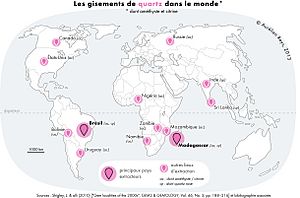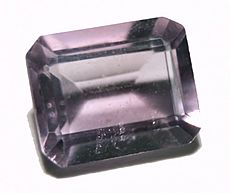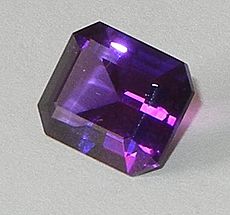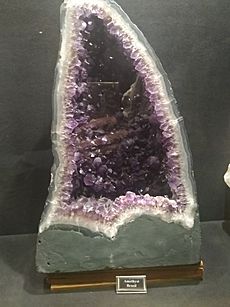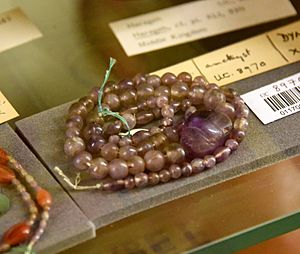Amethyst facts for kids
Quick facts for kids Amethyst |
|
|---|---|
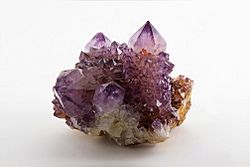
Amethyst cluster from Magaliesburg, South Africa.
|
|
| General | |
| Category | Silicate mineral |
| Formula (repeating unit) |
Silica (silicon dioxide, SiO2) |
| Crystal symmetry | P3221 (no. 154) |
| Identification | |
| Color | Purple, violet, dark purple |
| Crystal habit | 6-sided prism ending in 6-sided pyramid (typical) |
| Crystal system | Trigonal |
| Twinning | Dauphine law, Brazil law, and Japan law |
| Cleavage | None |
| Fracture | Conchoidal |
| Mohs scale hardness | 7–lower in impure varieties |
| Luster | Vitreous/glassy |
| Streak | White |
| Diaphaneity | Transparent to translucent |
| Specific gravity | 2.65 constant; variable in impure varieties |
| Optical properties | Uniaxial (+) |
| Refractive index | nω = 1.543–1.553 nε = 1.552–1.554 |
| Birefringence | +0.009 (B-G interval) |
| Pleochroism | Weak to moderate purple/reddish purple |
| Melting point | 1650±75 °C |
| Solubility | Insoluble in common solvents |
| Other characteristics | Piezoelectric |
Amethyst is a beautiful purple type of quartz. Its name comes from an old Greek word, amethystos. This word means "not drunk." Ancient Greeks believed the stone could protect them from getting drunk. They even wore amethyst and made drinking cups from it.
Amethyst is a semiprecious stone. People often use it in jewelry. It is also the traditional birthstone for February.
Contents
What is Amethyst?

Amethyst is a purple kind of quartz. Its scientific name is SiO2. The violet color comes from irradiation and tiny bits of iron. Sometimes, other transition metals are also present. These elements cause changes in the crystal structure. Amethyst is as hard as quartz. This makes it a good choice for jewelry.
Amethyst Colors and Shades
Amethyst can be light lavender or pale violet. It can also be a deep purple. Some amethyst stones show hints of red or blue. The best quality amethyst is found in places like Siberia, Sri Lanka, Brazil, and Uruguay.
The most desired color is called "Deep Siberian." This type is about 75–80% purple. It also has 15–20% blue and red colors. Another popular shade is ‘Rose de France’. This is a very light purple, like lavender or lilac. These lighter colors have become popular recently.
Sometimes, green quartz is wrongly called green amethyst. The correct name for green quartz is prasiolite. Other names for it are vermarine or lime citrine.
Amethyst often has different shades of color in one stone. The deepest color is usually at the crystal ends. Gem cutters try to make the finished stone have an even color. Sometimes, only a small part of a natural amethyst is purple. This means only a small part can be used for cutting.
The color of amethyst comes from iron in its structure. It also needs to be exposed to radiation. Natural amethyst can look reddish-violet or bluish-violet. If you heat amethyst, it can turn yellow-orange or brown. It might then look like citrine. However, real citrine keeps its two-color look, but heated amethyst does not. If amethyst is only partly heated, it can become ametrine.
Amethyst can lose its color if it stays in bright light too long. It can be made darker again with radiation. It does not glow under UV light.
Where Amethyst is Found
Amethyst is found in many places around the world. From 2000 to 2010, the most amethyst came from Brazil, Bolivia, Uruguay, and Zambia. Smaller amounts are found in Africa, Spain, Argentina, Russia, Mexico, and the United States.
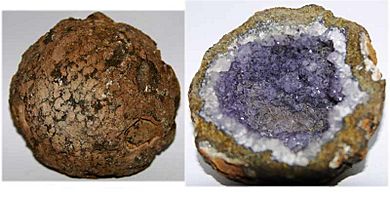
Brazil is a major producer of amethyst. It is found in large geodes inside volcanic rocks. Many hollow agates in Brazil and Uruguay have amethyst crystals inside. Artigas, Uruguay and the nearby Brazilian state of Rio Grande do Sul are big producers.
Amethyst is also mined in South Korea. Long ago, a large amethyst mine in Maissau, Austria, was important. Fine amethyst also comes from Russia. It is found in granite rocks. Zambia in southern Africa is one of the largest producers today. It produces about 1000 tons each year.
In the United States, amethyst is found in Arizona and Georgia. Smaller amounts are found in Colorado, Texas, and other states. Amethyst is common in Ontario and Nova Scotia, Canada. The biggest amethyst mine in North America is in Thunder Bay, Ontario.
Amethyst is the official state gemstone of South Carolina. Some South Carolina amethysts are shown at the Smithsonian Museum.
Amethyst Through History
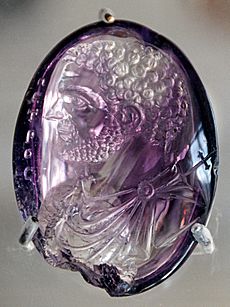
Ancient Egyptians used amethyst as a gemstone. They often carved designs into it.
In the Middle Ages, European soldiers wore amethyst amulets. They believed amethyst would protect them in battle. They also thought it could heal people and keep them calm. Amethyst beads have been found in Anglo-Saxon graves in England. Anglican bishops often wear a special ring with an amethyst.
A very large amethyst geode from Brazil was shown in Germany in 1902.
The meaning of amethyst has changed over time. In Feng Shui, it is thought to bring wealth. In ancient China, it was used to remove bad energy.
Man-Made Amethyst
Scientists can grow amethyst in a lab. This is called synthetic amethyst. They use a method called hydrothermal growth. This grows crystals in a high-pressure machine.
Man-made amethyst looks just like the best natural amethyst. It has the same chemical and physical features. It is very hard to tell them apart without special tests. One test looks for a specific crystal structure called "Brazil law twinning." This helps identify most man-made amethyst.
Some amethyst is treated with gamma rays, X-rays, or electron beams. This makes clear quartz turn purple. If this treated amethyst is heated, it can turn yellow or green. Much of the yellow quartz, like citrine, used in jewelry is actually "burnt amethyst."
Amethyst in Culture
People in Tibet believe amethyst is sacred to the Buddha. They make prayer beads from it. Amethyst is the birthstone for February. In the Middle Ages, it was a symbol of royalty. It was used to decorate English royal items. In the past, amethyst was one of the five most valuable gemstones. This changed when large amounts were found in Brazil.
How Amethyst is Valued
Before the 1700s, amethyst was as valuable as diamonds, sapphires, rubys, and emeralds. But after many large deposits were found in Brazil, its value dropped. Now, it is considered a semiprecious stone.
Collectors look for a deep color in amethyst. They also like stones with red flashes when cut. Amethyst is easy to find in large pieces. So, its value does not depend mainly on its weight (carat). This is different from most other gemstones. The color of the amethyst is the most important factor in its value.
The very best amethyst, called "Deep Russian," is very rare. When it is found, its value depends on what collectors are willing to pay. However, even the best amethyst is much less expensive than the best sapphires or rubies.
Caring for Amethyst
The best way to hold an amethyst gem is in a prong or bezel setting. Other settings should be used carefully.
Amethyst is quite hard. If you care for it properly, it will not get damaged. Amethyst is sensitive to strong heat. It can lose or change its color if exposed to heat or light for too long. Cleaning the stone with ultrasonic cleaners or steamers should be done with care.
See also
 In Spanish: Amatista para niños
In Spanish: Amatista para niños


